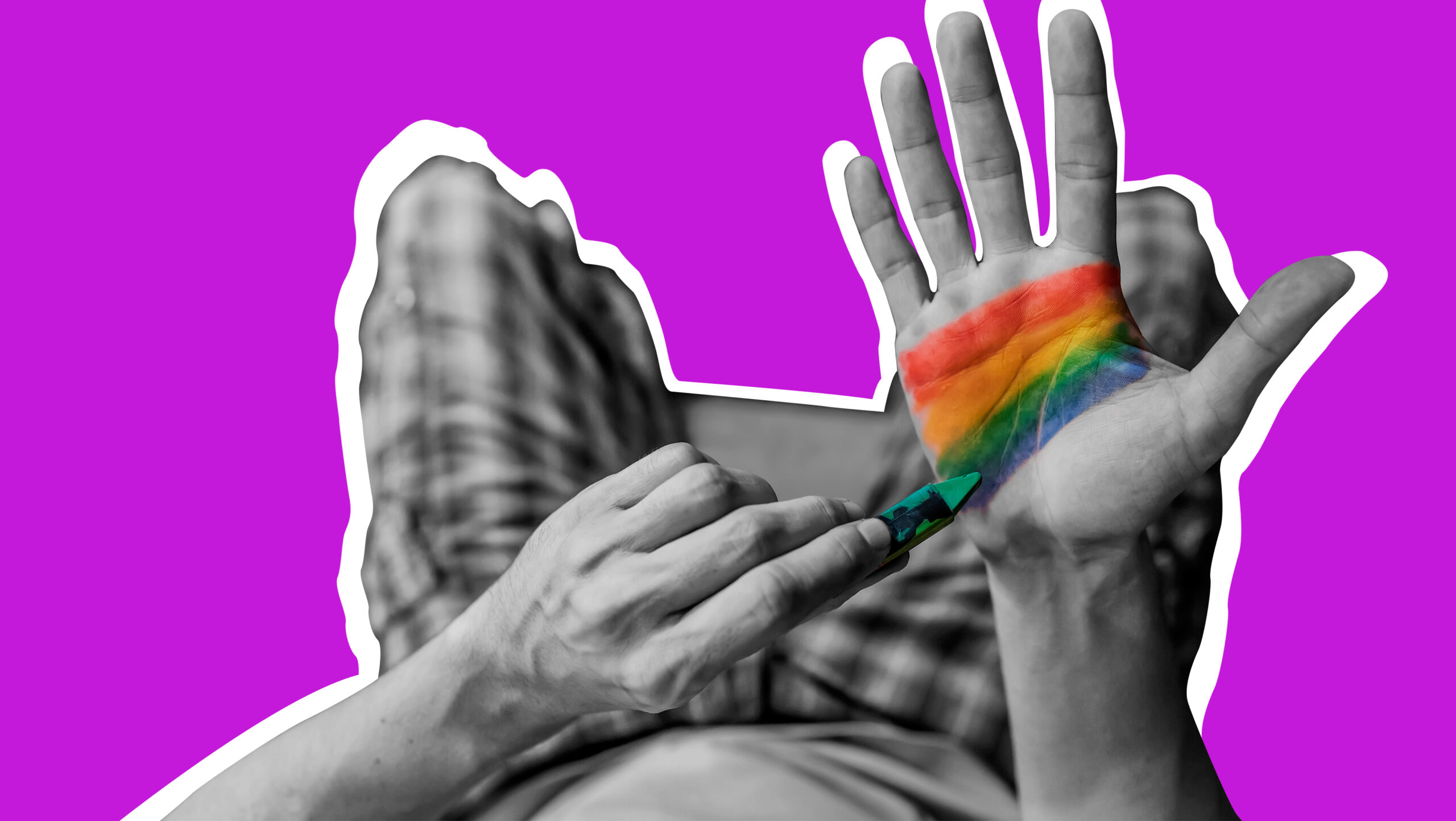In 2012, when he was 18 years old, BC native Andrew Perrin developed his first real crush on another man. Confused and anxious, having grown up in a highly religious evangelical community, Perrin confided in a friend who had also experienced same-sex attraction. She suggested he speak with a man who attended her Langley, BC church. He’d also had feelings for men, she said, but had overcome them and married a woman.
Perrin began meeting with the mentor once a week, then every month or two. The man explained that Perrin’s homosexuality was a result of the negative relationship he had with his father growing up. Perrin, he said, craved validation and support from men, and was misplacing this need as sexual attraction. Instead, he needed to focus on building positive platonic relationships with them.
The man gave Perrin exercises. Whenever he had romantic or sexual thoughts about another guy, Perrin was instructed to twist his hair around his finger and pull, as if he were tugging the thought straight out of his head. Mostly, though, they just talked. Perrin told his mentor about his crushes, while the man, a high school teacher, confessed that sometimes he felt attracted to some of his senior students.
At first the meetings helped. Perrin felt hopeful that he would be able to overcome his feelings and lead a “normal” life. He cut himself off from his female friends to make room for male friendships and avoided queer content, like his favourite show, Glee.
But when his attraction to men failed to disappear over time he became discouraged. He felt as though he was permanently broken, as though he’d failed. This shame and anxiety ate away at him. It took years — and an eventual breakdown — for him to realize he’d been subjected to a form of conversion therapy.
“Simply put: conversion therapy is a crock — and a dangerous one”
I first wrote about Perrin in 2018, while I was working on a feature story investigating conversion therapy in Canada. It’s a practice that, for a long time, I didn’t realize still existed. And there’s finally hope that it’ll be put to an end across the country. Bill S-260, introduced last month by Liberal Senator Serge Joyal, proposes to amend the Criminal Code to ban the advertising of conversion therapy in Canada. If S-260 becomes law, it will also become illegal to accept compensation for conversion therapy provided to those under the age of 18. Anyone found in violation could face up to five years in prison.
Conversion therapy — also known as reparative therapy — refers to any attempt to change a person’s sexual orientation or gender identity. It can take the form of spiritual counselling from churches or ministries, or secular interventions from a professional therapist. It has been denounced as harmful and ineffective by major psychological associations worldwide.
Simply put: conversion therapy is a crock — and a dangerous one. Currently, the practice is partially restricted in Ontario, Nova Scotia, Manitoba and the city of Vancouver. And a bill to regulate conversion therapy in Alberta is in the works.
Yet the process of outright banning it in Canada has been a difficult one. Bill S-260 arrived soon after an online petition urging a nationwide ban on conversion therapy was brought before the federal government. The petition, created by Devon Hargreaves of Lethbridge, Alberta and sponsored by NDP MP Sheri Benson, received more than 18,000 signatures before it was tabled in the winter. Still, when the government delivered its response in March, it noted that conversion therapy was a healthcare issue and flipped the onus back onto provinces to regulate the practice individually.
“Conversion therapies are immoral, painful and do not reflect the values of our government or those of Canadians,” the government wrote in its official response. Still, it continued, “This issue primarily implicates the regulation of the health profession, which is a provincial and territorial responsibility.”
Hargreaves, who ran in Alberta’s spring election, felt the response was inadequate, and is happy to see the federal government begin cracking down on providers of these so-called treatments. “Until they acknowledge that this is a problem, nothing will change,” he says.
But while activists agree Bill S-260 is a step in the right direction, it isn’t a perfect solution. Even if it becomes law, many instances of conversion therapy will remain legal.
Conversion therapy has a long history in Canada. As behavioural therapies rose in popularity throughout the 1950s, so did attempts to “treat” homosexuality in North America, sometimes through brutal methods like forced institutionalization, shock therapy, castration and, in years prior, lobotomies.
By the 1970s, progressive professionals were beginning to widely discredit the practice, and over the next few decades, studies revealed that not only was reparative therapy ineffective, it was also deeply harmful. Efforts to change a person’s sexuality or gender identity can lead to anxiety, depression, self-harm and suicide.
There are no official reports tracking conversion therapy in Canada, so it’s difficult to know just how many people are affected. In the US, though, a 2018 study from UCLA’s Williams Institute in Los Angeles found that nearly 700,000 lesbian, gay, bisexual and transgender adults have received it. Researchers estimated that an additional 57,000 youth will receive the reparative therapy from a religious advisor before they reach adulthood.
Last year, movies such as The Miseducation of Cameron Post and Boy Erased brought conversion therapy back into the popular imagination. Both films centred around teens who were involuntarily placed in conversion camps by their parents — a narrative many people imagine when they think about reparative therapy.
“As Perrin told me, ‘In the long term, [conversion therapy] kills you. Your sexuality becomes a battleground’”
In Canada, however, the practice often plays out differently. It may be offered by religious organizations through churches and ministries, or through secular providers. Some individual licensed therapists may still practise conversion therapy quietly — think of a therapist who tries to push gender non-conforming patients to align with their assigned gender, rather than giving them affirming care. More brashly, self-proclaimed secular groups like Quebec-based Ta Vie Ton Choix openly claim on their website to have assisted “thousands of men and women who have been liberated from the homosexual attractions against which they have been fighting.”
Like Perrin, recipients are often adults who willingly seek this treatment. Many of the survivors I spoke to last year described feeling unbearable disgust and guilt in relation to their sexual orientations. They often grew up in religious communities and feared they’d be ostracized if they came out. They saw conversion therapy as the only way to avoid isolation or damnation. Their queerness or gender non-conformity were painful, and they wanted them gone. As Perrin told me, “In the long term, [conversion therapy] kills you. Your sexuality becomes a battleground.”
Many sources who spoke with me underwent months or years of prayers, mentorship or talk therapy that eroded them slowly. They were isolated from other queer people. They were shamed. They were gaslit. And it destroyed them.
By 2014, separated from his friends, Perrin eventually became deeply lonely. He didn’t date, watch porn or masturbate, trying to completely shut down his sexual identity. He carried his shame alone, unable to talk to most of his social network about his feelings for fear of outing himself. He soon felt hopeless and suicidal, unable to complete school work, socialize or leave the house. It took the assistance of groups like the Gay Christian Network for Perrin to recognize that his religiousness and his queerness could co-exist. And he has been in a relationship with Josh, a fellow survivor of conversion therapy.
“Like most Canadians, ‘the government doesn’t seem to realize that there’s a real problem,’ Senator Joyal says”
These days, ministries, churches and secular organizations who perform the practice aren’t likely to explicitly say that being queer or trans is evil. Nor will they guarantee that they have the power to “turn” a person straight or cisgender. In fact, they rarely use the term “conversion therapy” at all. Groups typically try to stay discreet and operate through word-of-mouth referrals. To find them you need to know where to look.
Many of the survivors I spoke with were connected by word of mouth, through others in their religious communities. Once they had confided that they feared they might be gay, loved ones, teachers or church leaders offered to put them in touch with “ex-gays” in their community who had struggled with the same feelings, in the hopes that they could help others overcome them as well.
Online, providers rely on coded language, claiming to aid people with “achieving purity” or “breaking sexual bonds.” They position themselves as welcoming, compassionate sites. As I called different groups posing as someone looking for therapy, I was always greeted with soft, encouraging responses. The message was, “We can see you’re suffering, and we’re here to help.” This, compounded with the shame people feel entering the treatment, keep survivors silent and make reparative therapy groups incredibly hard to detect.
The fact that conversion therapy is so difficult to track has allowed it to remain unregulated, says Serge Joyal, the senator who introduced Bill S-260. “There has been a conspiracy of silence related to this issue,” Joyal told me. Like most Canadians, “the government doesn’t seem to realize that there’s a real problem.”
The issue has been on Joyal’s radar for a while: a parliamentary colleague had previously explained that the practice was ongoing in the country, which Joyal found alarming. When he saw the federal government’s response to last year’s petition — and that they were willing to formally condemn the practice — he knew he had to give another push. “If the government wants to be coherent with its approach, which is to protect Canadians, I think Parliament should legislate in relation to conversion therapy,” he says.
If it becomes law, Bill S-260 will offer some protections to Canadians. Healthcare professionals or other groups who charge fees will be affected if their patients are minors. And the most vocal organizations, who visibly advertise their services, could be as well. But adults who choose to pay for this destructive form of care will seemingly be left vulnerable as the proposed law refers only to providing treatment to people under the age of 18.
“To truly phase out the practice, bans need to apply even to those organizations operating in the shadows”
More concerning, religious groups who operate under the radar, through word-of-mouth, will potentially be unaffected. Since they may not even ask for compensation, their interventions might not be banned under the new Senate bill. Joyal also says that because religious freedom is enshrined in the charter, more comprehensive laws applying to religious groups would “require further examination.”
Bill S-260 will no doubt help bring awareness to the issue of conversion therapy, and will hopefully encourage government officials to learn how frequently it occurs in Canada and what forms it takes. But it doesn’t address the groups allowed to quietly carry on with impunity. To truly phase out the practice, bans need to apply even to those organizations operating in the shadows.
To eliminate conversion therapy, the government will have to make it illegal to even offer to change or reduce a person’s sexuality or gender non-conformity, regardless of the age of the participant or whether any cash changes hands. It will also have to set up a formal reporting system that survivors and activists feel comfortable using, and put time and resources into tracking the scope of the problem in Canada. It will need to help educate Canadians on what conversion therapy looks like — that it’s not all teen Bible Belt camps — and take a hard line against it. Only then will some of the country’s most vulnerable citizens be protected.


 Why you can trust Xtra
Why you can trust Xtra


